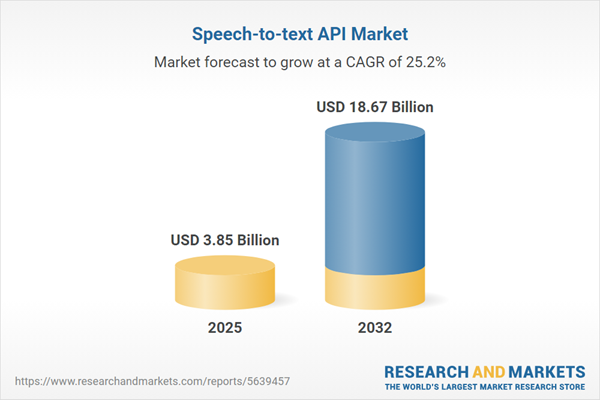Speak directly to the analyst to clarify any post sales queries you may have.
The speech-to-text API market is unlocking value for enterprises by converting spoken communication into structured, actionable data. Across diverse industries, this technology is enabling modernization, improving operational precision, and supporting informed business decisions within evolving digital strategies.
Market Snapshot: Speech-to-Text API Market Size and Trends
The global speech-to-text API market is experiencing steady growth through expanded integration in sectors such as healthcare, IT, media, and financial services. Market revenues are projected to rise from USD 3.08 billion in 2024 to USD 3.85 billion by 2025, reflecting a compound annual growth rate of 25.24%. This expansion is propelled by advancements in artificial intelligence, increasing demand for transcription accuracy across languages, and the need for streamlined integrations within enterprise cloud and automation strategies. Organizations leveraging these APIs are positioning themselves for resilient, adaptable operations that support ongoing digital transformation objectives.
Scope & Segmentation of the Speech-to-Text API Market
- Deployment Type: Cloud-based and on-premises solutions ensure organizations meet governance, security, compliance, and data sovereignty needs across varying IT environments.
- Component: Offerings include managed services, professional services, technology infrastructure, implementation support, and workforce enablement for enterprise-scale, secure, and scalable deployment.
- Transcription Mode: Real-time and offline transcription capabilities address both swift operational demands and intricate batch data needs for comprehensive workflow optimization.
- Industry Vertical: Solutions cater to banking, financial services, healthcare, government, education, IT, telecom, media, and entertainment, supporting compliance and sector-specific workflow requirements.
- End User: Platforms are adaptable for large enterprises, small to mid-sized businesses, and individual professionals, offering centralized and distributed operating models tailored to organizational needs.
- Regional Coverage: Market reach includes the Americas, Europe, Middle East, Africa, and Asia-Pacific, with enhancements for local language processing and regional compliance to ensure adaptability and scalability.
- Leading Companies Assessed: Vendors such as Google LLC, Amazon Web Services, Microsoft Corporation, IBM Corporation, Alibaba Group, Tencent Holdings, Baidu, iFLYTEK, Nuance Communications, and Deepgram are evaluated for innovation and partnership approaches.
Key Takeaways for Senior Decision-Makers
- Utilization of speech-to-text APIs streamlines team collaboration and drives workflow efficiency, particularly within hybrid and remote work environments by minimizing manual transcription burdens.
- Custom features tailored for sectors with high compliance requirements support regulatory adherence and improve accuracy in healthcare, legal, and financial operations.
- Flexible deployment models—cloud, on-premises, and hybrid—allow rapid adaptation to shifting privacy regulations and operational mandates worldwide.
- Integrating regional languages facilitates effective cross-border communication and streamlines regulatory and policy consistency for global organizations.
- Collaboration with telecom and hardware providers enhances infrastructure reliability and boosts the practical value realized from API investments.
- Advanced analytics and progress in natural language processing empower actionable insights, enable innovative initiatives, and provide more granular performance measurement for optimized process management.
Tariff Impact on Speech-to-Text API Procurement
Forthcoming United States tariffs in 2025 are influencing how enterprises approach procurement for both software and hardware within the speech-to-text API sector. Senior executives are proactively reassessing supplier partnerships, strengthening regional alliances, and revising contract terms to minimize disruption. Solution providers are also advancing their offerings and compliance programs to support clients in maintaining business continuity and operational agility amid evolving regulatory environments.
Methodology & Data Sources
This analysis uses a combination of secondary market research and direct interviews with enterprise users of speech-to-text API technologies. Quantitative market findings are validated through relevant case studies to ensure practical insights and support strategic planning for decision-makers navigating real-world operational challenges.
Why This Report Matters
- Guides leadership teams in aligning technology adoption with compliance objectives and scalable growth through clear market segmentation and strategic insights.
- Delivers actionable analysis for technological, regional, and sector-specific planning, empowering proactive risk mitigation in fluctuating business environments.
- Provides benchmarks and practical best practices that help organizations manage regulatory complexity and supply chain dynamics more effectively.
Conclusion
Speech-to-text APIs are supporting enterprise efficiency and flexibility. Strategic deployment of these platforms is key for organizations seeking to achieve digital transformation and reinforce operational resilience.
Additional Product Information:
- Purchase of this report includes 1 year online access with quarterly updates.
- This report can be updated on request. Please contact our Customer Experience team using the Ask a Question widget on our website.
Table of Contents
3. Executive Summary
4. Market Overview
7. Cumulative Impact of Artificial Intelligence 2025
Companies Mentioned
The companies profiled in this Speech-to-text API market report include:- Google LLC
- Amazon Web Services, Inc.
- Microsoft Corporation
- IBM Corporation
- Alibaba Group Holding Limited
- Tencent Holdings Limited
- Baidu, Inc.
- iFLYTEK Co., Ltd
- Nuance Communications, Inc.
- Deepgram, Inc.
Table Information
| Report Attribute | Details |
|---|---|
| No. of Pages | 188 |
| Published | October 2025 |
| Forecast Period | 2025 - 2032 |
| Estimated Market Value ( USD | $ 3.85 Billion |
| Forecasted Market Value ( USD | $ 18.67 Billion |
| Compound Annual Growth Rate | 25.2% |
| Regions Covered | Global |
| No. of Companies Mentioned | 11 |









